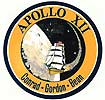In 2010, Sands of Time offered an extraordinary mosaic presented to Alan Bean, the lunar module pilot on Apollo 12.
We are very proud to now offer the second of the three mosaics personally gifted in 1969 by King Hussan II, King of Morocco to the three NASA Astronauts from Apollo 12, the second manned mission to land on the Moon.
Presented to Richard F. Gordon, the command module pilot of Apollo 12, this exquisite piece shows two pankratiast wrestlers; the wrestler to the left is in what seems to be a control technique by holding and entwining the legs of his opponent who is portrayed in the turtle position. The full scene is represented against a white background and surrounded by a square red then black border. Small tesserae are used to create the opponents who are colored in superb earth tones, with shades of browns, yellows, blacks and reds.
 Pankratiast wrestling: The Pankratiast sport is a combination of wrestling, boxing and martial arts. When two pankratiasts begin their contest, they stood with outstretched arms: the first objective being to gain a favorable position and grip, each trying to make the other stand so that the sun might shine in his face, or other inconveniences that might prevent his fighting with success. Each of the fighters might commence by boxing or wrestling, should he think he would be more successful in one rather than the other. The using of teeth and butting with the head were considered unfair fighting (kakomachein) and contrary to the law of the games (nomos enagonios). Victory was not decided until one of the parties was knocked out, or lifted up a finger, thereby declaring that he was unable to continue the contest either from pain or fatigue (Philostr. l. c.).
Pankratiast wrestling: The Pankratiast sport is a combination of wrestling, boxing and martial arts. When two pankratiasts begin their contest, they stood with outstretched arms: the first objective being to gain a favorable position and grip, each trying to make the other stand so that the sun might shine in his face, or other inconveniences that might prevent his fighting with success. Each of the fighters might commence by boxing or wrestling, should he think he would be more successful in one rather than the other. The using of teeth and butting with the head were considered unfair fighting (kakomachein) and contrary to the law of the games (nomos enagonios). Victory was not decided until one of the parties was knocked out, or lifted up a finger, thereby declaring that he was unable to continue the contest either from pain or fatigue (Philostr. l. c.).
Usually one of the combatants, by some trick or other, made his antagonist fall to the ground, and the wrestling that then commenced was called anaklinopale (more commonly known as Kato Pale, ground wrestling), and continued until one of the parties declared himself conquered or was strangled. Edited excerpt from A Dictionary of Greek and Roman Antiquities (1890) (eds. William Smith, LLD, William Wayte, G. E. Marindin) at the Perseus Archives.
“Pankratiasts…must employ backward falls which are not safe for the wrestler and grips in which victory must be obtained by falling…They must have skill in various methods of strangling; they also wrestle with an opponent’s ankle and twist his arm, besides hitting and jumping on him, for all these practices belong to the pankration, only biting and gouging prohibited. The Spartans allow even these practices, but the Eleans and the laws of the games exclude them.” Philostratus, On Gymnastics From Olympic Games Study Guide (4)
In Rome the Pankratiast (or Roman Pancratium) is first mentioned in the games which Caligula gave to the people (Dion Cass. LIX.13). After this time it seems to have become extremely popular, and Justinian made it one of the seven solemnities which the consuls had to provide for the amusement of the people.
Provenance: After the Apollo 12 flight, Mission commander Charles “Pete” Conrad, Lunar Module Pilot Alan L. Bean and Command Module Pilot Richard F. Gordon, together with their wives were invited to spend the night at The White House by President and Mrs. Nixon.
In the evening, after dinner, The President asked the party to visit the leadership of 21 countries around the world, as his direct personal representatives, to relate the story of their moon landing mission. To facilitate this assignment they used Air Force One aircraft with two complete flight crews and a number of State Department coordinators. As representatives of The President of the United States they were treated with much celebration and respect everywhere they went.
In Morocco, King Hussan II presented each astronaut with a fine mosaic panel, Richard Gordan received “The Wrestlers” now offered for sale by Sands of Time Ancient Art



